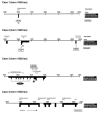Long-term course of severe depression: late remission and recurrence may be found in a follow-up after 38-53 years
- PMID: 25478118
- PMCID: PMC4253380
- DOI: 10.4081/mi.2012.e17
Long-term course of severe depression: late remission and recurrence may be found in a follow-up after 38-53 years
Abstract
This study is a follow-up of inpatients diagnosed with severe depression/melancholia between 1956 and 1969. During this period, all inpatients at the Department of Psychiatry, University Hospital, Lund, were rated on a multidimensional diagnostic schedule on discharge. There were 471 patients born from 1920 onward. In the present follow-up, 2006 to 2010, 169 survivors could be traced. They were asked to participate in the study involving a telephone interview, in which a structured life chart was used. Of the patients contacted, 16 were ill or confused and 3 did not remember ever being depressed, leaving 150 who could participate. Seventy-five of these agreed to participate in the study. Long-term course of depression was evaluated by cluster analysis and compared to background variables, such as heredity for depression, perceived parental rearing behaviour, and treatment of index depressive episode. Using a cluster analysis the patients could be separated into six clusters describing the course: i) single or few episodes followed by long-lasting remission; ii) single or few episodes followed by long-lasting remission, although shorter; iii) single or few episodes followed by late recurrence; iv) single or few episodes, but more frequently ill, followed by late recurrence; v) several episodes followed by lasting remission; vi) chronic course of episodes. Remission or recurrence could therefore occur even after more than a decade. In summary, there was a short-term course with or without recurrence or a chronic course with or without late remission. Heredity for depression was significantly related to a chronic course with or without late remission.
Keywords: long-term course; recovery.; remission; severe depression.
Conflict of interest statement
Conflict of interests: the authors report no potential conflict of interests.
Figures
Similar articles
-
Rates and predictors of remission, recurrence and conversion to bipolar disorder after the first lifetime episode of depression--a prospective 5-year follow-up study.Psychol Med. 2016 Apr;46(6):1151-61. doi: 10.1017/S0033291715002676. Epub 2016 Jan 8. Psychol Med. 2016. PMID: 26743873
-
The course of depression in late life as measured by the Montgomery and Asberg Depression Rating Scale in an observational study of hospitalized patients.BMC Psychiatry. 2015 Aug 5;15:191. doi: 10.1186/s12888-015-0577-8. BMC Psychiatry. 2015. PMID: 26242794 Free PMC article.
-
Childhood neglect predicts the course of major depression in a tertiary care sample: a follow-up study.BMC Psychiatry. 2017 Mar 28;17(1):113. doi: 10.1186/s12888-017-1270-x. BMC Psychiatry. 2017. PMID: 28351403 Free PMC article.
-
Novel Augmentation Strategies in Major Depression.Dan Med J. 2017 Apr;64(4):B5338. Dan Med J. 2017. PMID: 28385173 Review.
-
[Impact of life events in the course of depression].Encephale. 1993 Aug;19 Spec No 3:481-9. Encephale. 1993. PMID: 8299547 Review. French.
Cited by
-
Taking care of oneself by regaining control - a key to continue living four to five decades after a suicide attempt in severe depression.BMC Psychiatry. 2017 Feb 13;17(1):69. doi: 10.1186/s12888-017-1223-4. BMC Psychiatry. 2017. PMID: 28193192 Free PMC article.
-
Vulnerability for new episodes in recurrent major depressive disorder: protocol for the longitudinal DELTA-neuroimaging cohort study.BMJ Open. 2016 Mar 1;6(3):e009510. doi: 10.1136/bmjopen-2015-009510. BMJ Open. 2016. PMID: 26932139 Free PMC article.
-
Suicidal Career in Severe Depression among Long-Term Survivors: In a Followup after 37-53 Years Suicide Attempts Appeared to End Long before Depression.Depress Res Treat. 2013;2013:610245. doi: 10.1155/2013/610245. Epub 2013 Dec 23. Depress Res Treat. 2013. PMID: 24455226 Free PMC article.
-
Four Reasons Why Assisted Dying Should Not Be Offered for Depression.J Bioeth Inq. 2017 Mar;14(1):151-157. doi: 10.1007/s11673-016-9759-4. Epub 2016 Dec 8. J Bioeth Inq. 2017. PMID: 27933459 Review.
References
-
- World Health Organization. Depression. What is depression? Available from: http://www.who.int/mental_health/management/depression/definition/en/
-
- Mattisson C, Bogren M, Nettelbladt P, et al. First incidence depression in the Lundby Study: a comparison of the two time periods 1947-1972 and 1972-1997. J Affect Dis. 2005;87:151–60. - PubMed
-
- Murphy JM, Laird NM, Monson RR, et al. Incidence of depression in the Stirling County Study: historical and comparative perspectives. Psychol Med. 2000;30:505–14. - PubMed
-
- American Psychiatric Association. Diagnostic and statistical manual of mental disorders. (DSM IV) Fourth Edition. DSM- IV Washington, DC: American Psychiatric Association; 1994.
-
- Lafer B, Nierenberg AA, Rosenbaum JF, Fava M. Outpatients with DSM-III-R versus DSM-IV melancholic depression. Compr Psychiatry. 1996;37:37–9. - PubMed
Publication types
LinkOut - more resources
Full Text Sources

